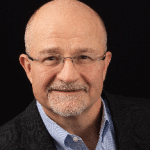For those who like to look deep into the structure and causes of change, something fun is in process: an interview with Vint Cerf, with an explicit e-patient component.
Cerf is acknowledged as one of the fathers of the internet. In my lifetime few people, if any, have contributed more to ground-breaking, earth-shaking change.
The interview was conducted by Kim Chandler McDonald (@KimmiCFlatWorld), formerly of Amsterdam’s English Breakfast Radio Show and now in Australia. The result was long enough that she broke it into two parts; Part 1 is here, and Part 2 will be next week. I got the chance to ask Cerf about e-patients and the internet, and the question was accepted (woot!) – the answer will be in Part 2.
Caveat: this will be of no interest to business people who are wondering about next quarter’s profits or their 2012 strategic plan. This is about deep structural change that leads on to a permanent shift in how the world works. And BOY do we need that in healthcare.
Cerf reflects on the changes he’s seen in his life (born 1943), how the ARPANET evolved to the internet, and the difference between routine innovation and capital-I Innovation, which may take years to unfold. (That’s of no use to the impatient, but invaluable to those who plant the seeds of long-term change.) And check out the two inventions he was sure would become reality last century, and didn’t. :–)
Part 1 ends with a discussion of Australia’s national broadband initiative. He notes:
…with the fact that everybody is online, or very nearly everybody, you can begin to say, “We are going to do ‘X‘ for the entire population,” and have a reasonable expectation that you will, in fact, reach the entire population.
For example, when it comes to healthcare, and the possibility of remote diagnosis and things like that, you’d be in a position to actually exercise that idea.
Consider this timeline:
- The ARPANET became the internet in 1983 – just 28 years ago.
- He dates the first browser at 1993, ten years later.
- The Mozilla browser, widely considered the one that broke things open, was April 1994.
- In January 1995, less than a year later, our “Doc Tom” Ferguson published his prescient “triangle slides” that foresaw how the Web was turning medicine on its head. (See our post Steal These Slides, July 2008, when those slides were discovered in Doc Tom’s “attic.”)
- Ten years after Mozilla, Tim O’Reilly coined the term “Web 2.0,” about the evolution of the web from read-only (a place to publish) to including user-generated content: the web became something whose content was heavily influenced by the people who use it, with blogs, online forums, and ultimately the entire world of what we now call social media. (Here’s a paper he co-authored with John Battelle five years after that.)
We’re now seven years into Web 2.0, 17 years since Mozilla, 28 since the whole thing started. Where the HECK will we be in 2039, another 28 years along?? That’s the world the next generation will live in.
I asked Vint about the democratization of information, which is at the core of the e-patient movement. Can’t wait to see the answer.
p.s. I no longer capitalize “internet” because I agree with the Pew Internet & American Life Project’s style: it’s such a part of the fabric of life that they now consider it a common noun. How’s that for a change that took root?






I’m really pleased that you found the piece interesting Dave!
By the way, I too no longer capitalize internet, but I did find it interesting that Vint believes, as do I, that Cloud – at least at this stage – deserves capitalization.
When it comes to eHealth in Australia, it is very clear that Australia has a proud tradition of adapting health care to match the geographical barriers and vast remoteness of the continent.
For example, in 1928 the Royal Flying Doctors Service commenced servicing those living in rural, remote and regional areas of Australia utilizing the, then, new technologies of motorised flight and radio.
The struggle to deliver high standard of health to all Australians has mean pushing the envelope of technological advances. I have no doubt that transformational technologies, such as the NBN (broadband) and KimmiC’s FlatWorld will facilitate what comes next in that long line of innovation.